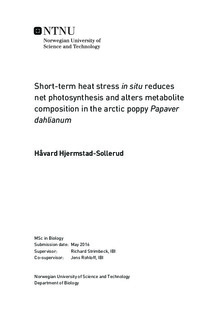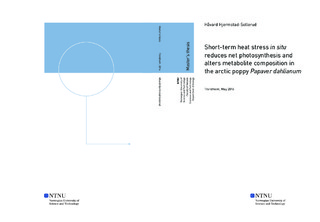| dc.description.abstract | Climate change is increasing the mean summer temperature in the Arctic and with that the probability of extreme climatic events including heat waves. An increase in heat waves may cause increased stress in a number of arctic plants, but to what extent, is a current research question. There was no evidence of an increase in the frequency, length or average daily maximum temperature of heat waves at Longyearbyen, Svalbard. Irrespective of future changes in temperature, present conditions could result in leaf temperatures upwards of 30 °C. I investigated the photosynthetic and metabolomic responses of Papaver dahlianum Nordh. to a short-term heating (17, 24 and 31 °C) event (45 min) in a field study on Svalbard. Net photosynthesis declined in single leaves with an increase in temperature along with a corresponding decrease in stomatal conductance (gs) and sub-stomatal CO2 concentration (Ci). The reduction in net photosynthesis persisted after a return to 13 °C in the 31 °C heat treatment. Elevated temperatures caused an increase in metabolic activity, (likely) alterations in membrane composition, and an accumulation of metabolites related to or with direct antioxidant capabilities, indicating that plants experienced photoinhibition both directly after and two hours after heating. | |

